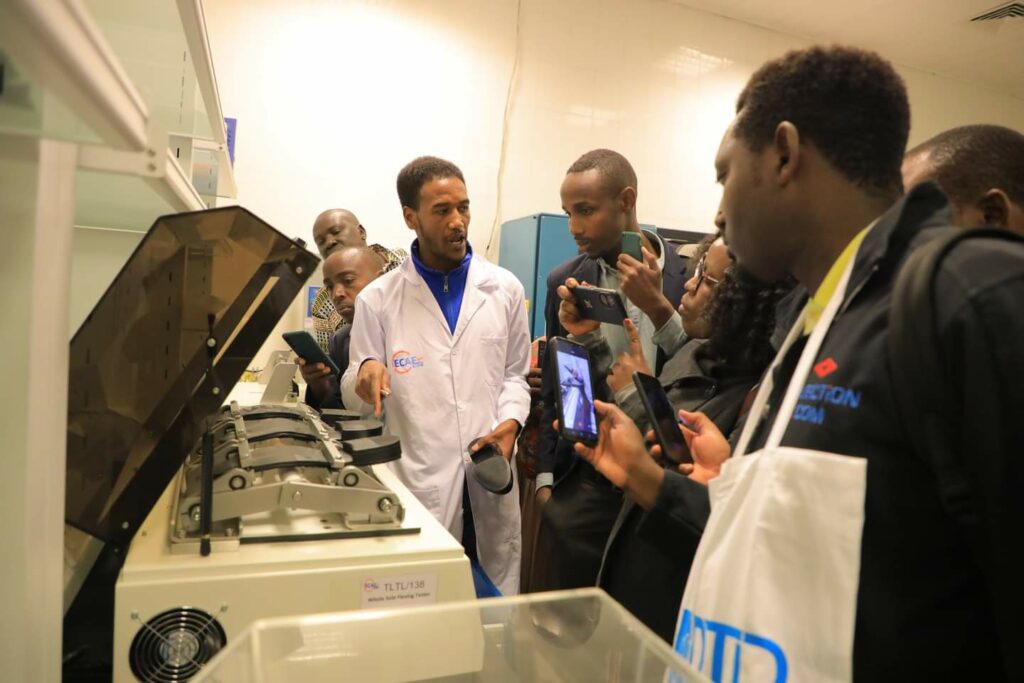The Physikalisch-Technische Bundesanstalt (PTB) and the East African Community (EAC), supported by the Gesellschaft für Agrarprojekte (GFA), conducted a joint study tour to Addis Abeba, Ethiopia between 19 and 23 June. This visit was part of the project “Strengthening of the Quality Infrastructure of Selected Sectors in the EAC”, which is funded by the German Federal Ministry for Economic Cooperation and Development (BMZ). The project aims to advance the Quality Infrastructure (QI) in the region’s leather value chain. As the Ethiopian leather sector is considered highly developed by the EAC, this study tour was organised to learn more about the role of QI in the development of the Ethiopian leather sector.
The EAC itself has highlighted the leather sector and prioritized it, as it offers a large potential for economic development in the region. During the five-day study tour, the delegation visited the Colba tannery, a shoe-producing company named George Shoe, the Lidi leather training centre, the Ethiopian Conformity Assessment Enterprise (ECAE), and the Africa Leather and Leather Products Institute (ALLPI), as well as the Ethiopia Leather Industries Association (ELIA) and one of the country’s Leather Industrial Parks. Furthermore, Sascha Dietrich and Michael Meyer from the German FILK institute conducted technical training. FILK, by the way, is an institute for research, development, and testing materials, including leather. The participants ranged from owners of small and medium-sized tanneries to leather manufacturers, representatives of leather associations, leather testing specialists, and industrial ministry representatives.
The delegation valued several measures undertaken by Ethiopia to improve its leather industry. These included the establishment of internationally accredited testing and research laboratories as per ISO/IEC 17025: 2008 and the establishment of a strong ELIA, with members drawn from over 28 tanneries, 35 footwear manufacturers, 128 leather product manufacturers, along with many other organizations.
The country has also established its own unique leather brand of “Ethiopia Highland Leather”. This is made from sheepskin and is backed by scientific research. In addition, Ethiopia regularly organizes the All Africa Leather Fair (AALF).
The region is yet to exploit its potential

The delegation was headed by the Director of Productive Sectors of the EAC Secretariat, Jean Baptiste Havugimana. According to a press release by the EAC, he pointed out that the region is yet to exploit the potential of the leather industry despite having a livestock population of over 200 million and offtake rates at over 20 %. “The EAC Regional Leather Strategy for the period 2020-2030 emphasizes the importance of establishing a solid QI framework for the sector in order to produce quality products. Despite this, the leather industry QI remains limited in metrology, standardization, accreditation, and conformity assessment across the value chain,” said Havugimana in a kick-off meeting held at the ECAE.
“PTB is supporting the EAC region in strengthening its own capacity to manage and coordinate the quality assurance activities of its leather sector. And PTB will support the Partner States in undertaking product testing correctly, among other measures,” noted Ann-Margret Bolmer, International Project Coordinator from the PTB’s Sub-Saharan Africa unit within PTB’s International Cooperation group. She informed the meeting that Germany’s national institute of metrology had supported the Partner States in a number of ways. These included developing a Quality Management System (QMS) Self-Assessment Tool for micro, small, and medium-sized enterprises (SMEs) and providing some leather testing laboratory equipment to EAC’s National Bureaus of Standards.
Images © Beatrice Mwasi








